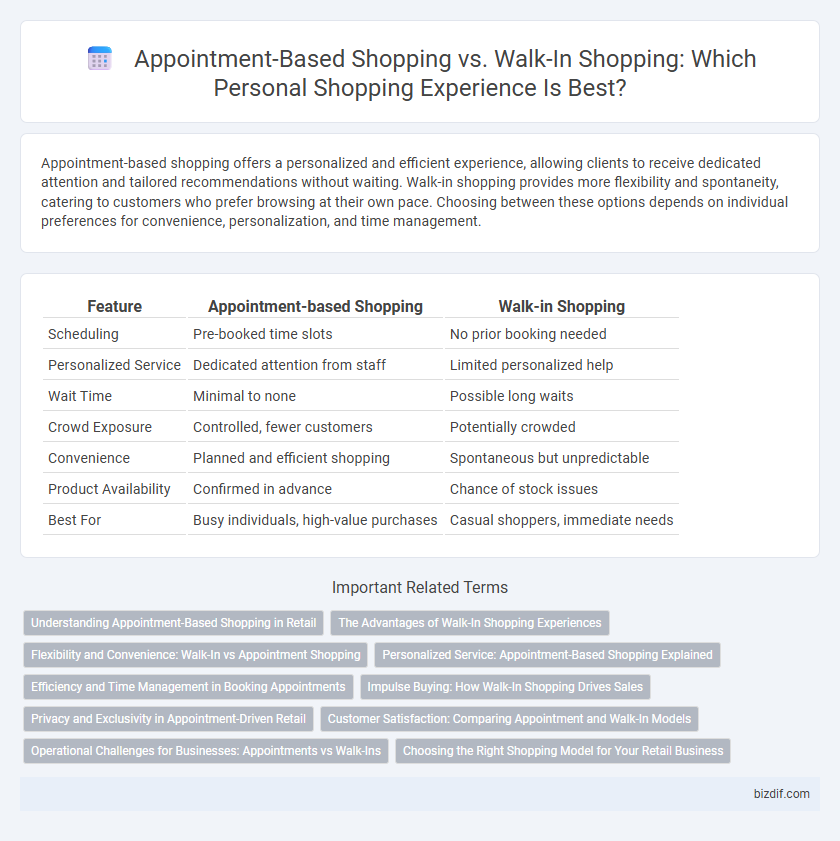Appointment-based shopping offers a personalized and efficient experience, allowing clients to receive dedicated attention and tailored recommendations without waiting. Walk-in shopping provides more flexibility and spontaneity, catering to customers who prefer browsing at their own pace. Choosing between these options depends on individual preferences for convenience, personalization, and time management.
Table of Comparison
| Feature | Appointment-based Shopping | Walk-in Shopping |
|---|---|---|
| Scheduling | Pre-booked time slots | No prior booking needed |
| Personalized Service | Dedicated attention from staff | Limited personalized help |
| Wait Time | Minimal to none | Possible long waits |
| Crowd Exposure | Controlled, fewer customers | Potentially crowded |
| Convenience | Planned and efficient shopping | Spontaneous but unpredictable |
| Product Availability | Confirmed in advance | Chance of stock issues |
| Best For | Busy individuals, high-value purchases | Casual shoppers, immediate needs |
Understanding Appointment-Based Shopping in Retail
Appointment-based shopping in retail offers customers a personalized and streamlined experience, allowing them to schedule specific time slots with sales associates for dedicated attention. This approach reduces wait times, enhances customer service quality, and enables retailers to manage store traffic efficiently. Retailers leveraging appointment-based models report higher customer satisfaction and increased sales conversion rates due to tailored interactions.
The Advantages of Walk-In Shopping Experiences
Walk-in shopping offers immediate access to products without the need for prior scheduling, providing flexibility for spontaneous purchases. Shoppers benefit from the freedom to explore a wider range of items and receive personalized assistance on demand. This convenience enhances customer satisfaction by accommodating varying schedules and preferences seamlessly.
Flexibility and Convenience: Walk-In vs Appointment Shopping
Walk-in shopping offers maximum flexibility, allowing customers to visit stores at their convenience without prior scheduling, which suits spontaneous purchases and quick trips. Appointment-based shopping enhances convenience through personalized service and dedicated time slots, reducing wait times and ensuring focused attention from staff. Choosing between the two depends on customer preference for either flexible timing or a tailored, uninterrupted shopping experience.
Personalized Service: Appointment-Based Shopping Explained
Appointment-based shopping guarantees personalized service by allowing shoppers to schedule dedicated time with a sales associate who tailors product recommendations based on individual preferences and needs. This focused interaction enhances the shopping experience by minimizing wait times and providing expert guidance, resulting in more satisfying and efficient purchases. Retailers benefit from increased customer loyalty and higher conversion rates due to this customized approach.
Efficiency and Time Management in Booking Appointments
Appointment-based shopping enhances efficiency by allowing customers to reserve specific time slots, reducing wait times and enabling personalized service. This method streamlines time management for both shoppers and retailers by predicting customer flow, minimizing overcrowding, and optimizing staff allocation. In contrast, walk-in shopping often results in unpredictable wait periods and less tailored assistance, potentially decreasing overall shopping efficiency.
Impulse Buying: How Walk-In Shopping Drives Sales
Walk-in shopping significantly boosts impulse buying by exposing customers to unplanned product discoveries and immediate purchase opportunities. The spontaneous nature of walk-ins increases the likelihood of emotional purchases driven by in-store promotions, product displays, and sensory experiences. Retailers leveraging walk-in traffic can enhance sales by strategically positioning high-margin and seasonal items in high-visibility areas.
Privacy and Exclusivity in Appointment-Driven Retail
Appointment-based shopping ensures a higher level of privacy by limiting the number of customers in-store, creating an exclusive environment tailored to individual preferences. Retailers can allocate dedicated time slots for each client, enhancing personalized service and minimizing distractions. This exclusivity fosters trust and comfort, making it ideal for high-end or sensitive purchases.
Customer Satisfaction: Comparing Appointment and Walk-In Models
Appointment-based shopping enhances customer satisfaction by offering personalized attention, reduced wait times, and tailored product recommendations that align with individual preferences. Walk-in shopping provides flexibility and spontaneity but often leads to longer waits and less customized service, potentially impacting overall satisfaction. Retailers adopting appointment models report higher repeat business and positive feedback due to the focused and efficient shopping experience.
Operational Challenges for Businesses: Appointments vs Walk-Ins
Appointment-based shopping requires businesses to manage schedules efficiently, ensuring staff availability aligns with customer bookings, which can increase operational complexity and require sophisticated booking systems. Walk-in shopping demands flexible staffing to handle unpredictable customer flow, leading to potential overstaffing or understaffing and impacting labor costs. Balancing these models involves optimizing resource allocation while maintaining high service levels, often necessitating integrated workforce management tools and real-time data analysis.
Choosing the Right Shopping Model for Your Retail Business
Appointment-based shopping offers personalized customer experiences and efficient time management, making it ideal for high-end retail businesses aiming to enhance customer satisfaction. Walk-in shopping provides flexibility and spontaneity, attracting a broader customer base and driving higher foot traffic for stores with diverse product ranges. Retailers should analyze target audience preferences and operational capacity to select the shopping model that maximizes sales and customer engagement.
Appointment-based shopping vs Walk-in shopping Infographic

 bizdif.com
bizdif.com